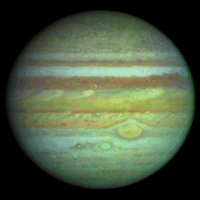The Planet
Jupiter
 The planet
Jupiter is shown in the adjacent Hubble Space Telescope
true-color image
(Ref).
Jupiter is by far the largest of the planets. It is more
than twice as massive as all other planets combined; if it had
been only about 100 times more massive at birth (not so much by astronomical
standards) it would have become a star instead of a planet. Then the Solar
System might be a double star system instead of a single star with a planetary
system.
The planet
Jupiter is shown in the adjacent Hubble Space Telescope
true-color image
(Ref).
Jupiter is by far the largest of the planets. It is more
than twice as massive as all other planets combined; if it had
been only about 100 times more massive at birth (not so much by astronomical
standards) it would have become a star instead of a planet. Then the Solar
System might be a double star system instead of a single star with a planetary
system.
Jupiter has features very different from terrestrial planets. Its
composition is more like that of stars, and if it has any solid surface it is
hidden deep at its center: Jupiter is apparently almost entirely gas and
liquid. It also has an internal energy source and enormous magnetic fields.
Finally, the 4 largest moons of Jupiter (the Galilean Moons) are sufficiently
interesting in their own right that they are among the most studied objects in
the Solar System. We shall devote a separate section to studying their
properties.
Our most detailed information concerning Jupiter has come from the space probes
Pioneer 10 (1973), Pioneer 11 (1974), Voyager I (March, 1979), Voyager
II (July, 1979), and Galileo (1995-present). The first 4 were flyby missions;
the Galileo probe was inserted into orbit around Jupiter December, 1995, and
launched a probe into the atmosphere that transmitted information before being
destroyed. The
Galileo orbiter is in a complex orbit that has been examining Jupiter
and the Galilean moons.
 The planet
Jupiter is shown in the adjacent Hubble Space Telescope
true-color image
(Ref).
Jupiter is by far the largest of the planets. It is more
than twice as massive as all other planets combined; if it had
been only about 100 times more massive at birth (not so much by astronomical
standards) it would have become a star instead of a planet. Then the Solar
System might be a double star system instead of a single star with a planetary
system.
The planet
Jupiter is shown in the adjacent Hubble Space Telescope
true-color image
(Ref).
Jupiter is by far the largest of the planets. It is more
than twice as massive as all other planets combined; if it had
been only about 100 times more massive at birth (not so much by astronomical
standards) it would have become a star instead of a planet. Then the Solar
System might be a double star system instead of a single star with a planetary
system.